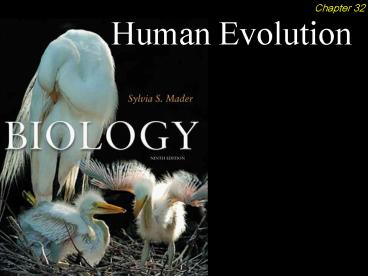Photosynthesis - PowerPoint PPT Presentation
Title:
Photosynthesis
Description:
Evolution of Primate Hand. Binocular Vision. Stereoscopic vision. Depth perception ... Allows primates to make accurate judgments about distance and position ... – PowerPoint PPT presentation
Number of Views:38
Avg rating:3.0/5.0
Title: Photosynthesis
1
(No Transcript)
2
Outline
- Evolution of Primates
- Mobile Limbs
- Binocular Vision
- Evolution of Early Hominids
- Evolution of Later Hominids
- Evolution of Early Homo
- Modern Humans
- Human Variation
3
Evolution of Primates
- The evolution of primates is characterized by
trends towards - Mobile limbs
- Grasping hands
- A flattened face
- Binocular vision
- A large, complex brain, and
- A reduced reproductive rate
4
Primate Diversity
5
Mobile Limbs
- Hands and feet
- Most primates have flat nails
- Sensitive pads on the undersides of fingers and
toes - Many also have both an opposable big toe and
thumb - Mobile limbs and clawless opposable digits allow
primates to freely grasp and release tree limbs
6
Evolution of Primate Hand
7
Binocular Vision
- Stereoscopic vision
- Depth perception
- Allows primates to make accurate judgments about
distance and position of adjoining tree limbs
8
Binocular Vision
9
Primate Characteristics
- Opposable thumb
- Nails instead of claws
- Single births
- Binocular vision
- Expanded, complex brain
- Emphasis on learned behavior
10
Evolution of Primates
- Prosimians were the first type of primate to
diverge from the human line - Surviving anthropoids are classified into three
superfamilies - New World monkeys
- Old World monkeys
- Hominoids
11
Evolution of primates
12
Evolution of Hominids
- Proconsul is believed ancestral to hominids
- Phylogenetic tree indicates humans are most
closely related to African apes - Genetic changes used as a molecular clock to
measure relatedness of different groups - Last common ancestor appears to have lived about
7 mya
13
Monkey SkeletonCompared to Proconsul Skeleton
14
Hominids
- Hominid fossils
- Must have an anatomy suitable for standing erect
and walking on two feet - Bipedalism
- Skeletal differences between humans and apes
largely because - Humans are bipedal, while
- Apes are quadrupedal
15
Adaptations for Standing
16
Australopithecines
- Australopithecines
- Evolved and diversified in Africa 4 mya
- Possibly a direct ancestor of humans
- Southern Africa
- Australopithecus africanus
- Eastern Africa
- Australopithecus afarensis
17
Human Evolution
18
Australopithecus afarensis
19
Evolution of Early Homo
- Homo habilis
- Dated between 20 an 19 mya
- May be ancestral to modern humans
- Skulls suggest portions of the brain associated
with speech were enlarged - Ability to speak may have led to hunting
cooperatively and the advent of culture
20
Homo erectus
- Homo erectus and similar fossils
- Found in Africa, Asia, and Europe
- Dated between 19 and 03 mya
- Larger brain and flatter face than Homo habilis
- Much taller than previous hominids
- Thought to have first appeared in Africa and then
migrated into Asia and Europe - First hominid to use fire
21
Homo ergaster
22
Evolution of Modern Humans
- Most researchers believe Homo sapiens evolved
from Homo erectus - Multiregional Continuity Hypothesis
- Similar evolution occurred in many different
places - Out-of-Africa Hypothesis
- H. sapiens evolved from H. erectus only in
Africa, and thereafter migrated to Europe
23
Evolution of Modern Humans
24
Neanderthals
- Neanderthal (H. neanderthalensis) skeletons were
first discovered in Germanys Neander Valley - Skeletons date back 200,000 years
- Massive brow ridges with protruding nose, jaws,
and teeth - Heavily muscled
- Culturally advanced
- Manufactured variety of tools
25
Neandertals
26
Cro-Magnons
- Oldest fossils to be designated H. sapiens
- Modern humans who entered Asia and Europe from
Africa 100,000 years ago - Made advanced stone tools
- Accomplished hunters
- Hunted cooperatively
- First to have language
27
Cro-Magnons
28
Human Variation
- Hypothesized that human variations evolved as
adaptations to local environmental conditions - Bergmanns Rule - Animals in colder regions of
their range have a bulkier body build - Allens Rule - Animals in colder regions of their
range have shorter limbs, digits, and ears - Comparative study of mitochondrial DNA
- Suggests human populations have a common ancestor
no more than a million years ago
29
Ethnic Groups
30
Review
- Evolution of Primates
- Mobile Limbs
- Binocular Vision
- Evolution of Early Hominids
- Evolution of Later Hominids
- Evolution of Early Homo
- Modern Humans
- Human Variation
31
(No Transcript)

